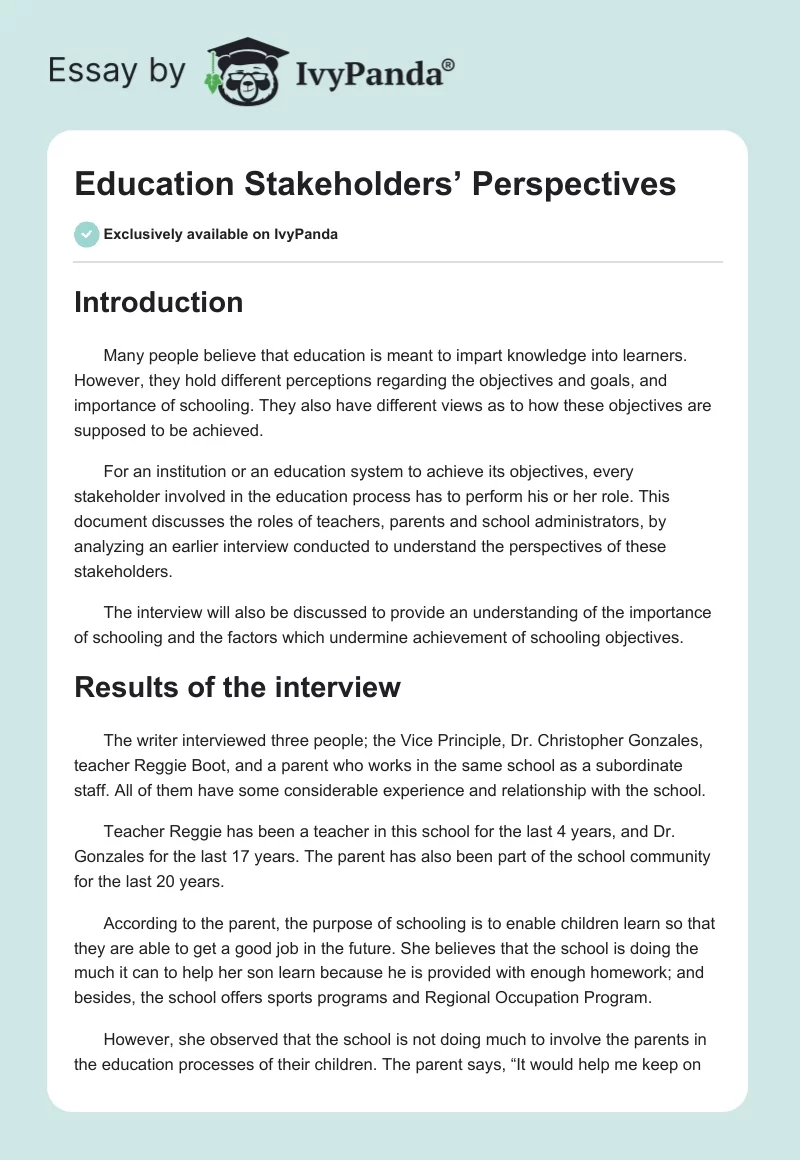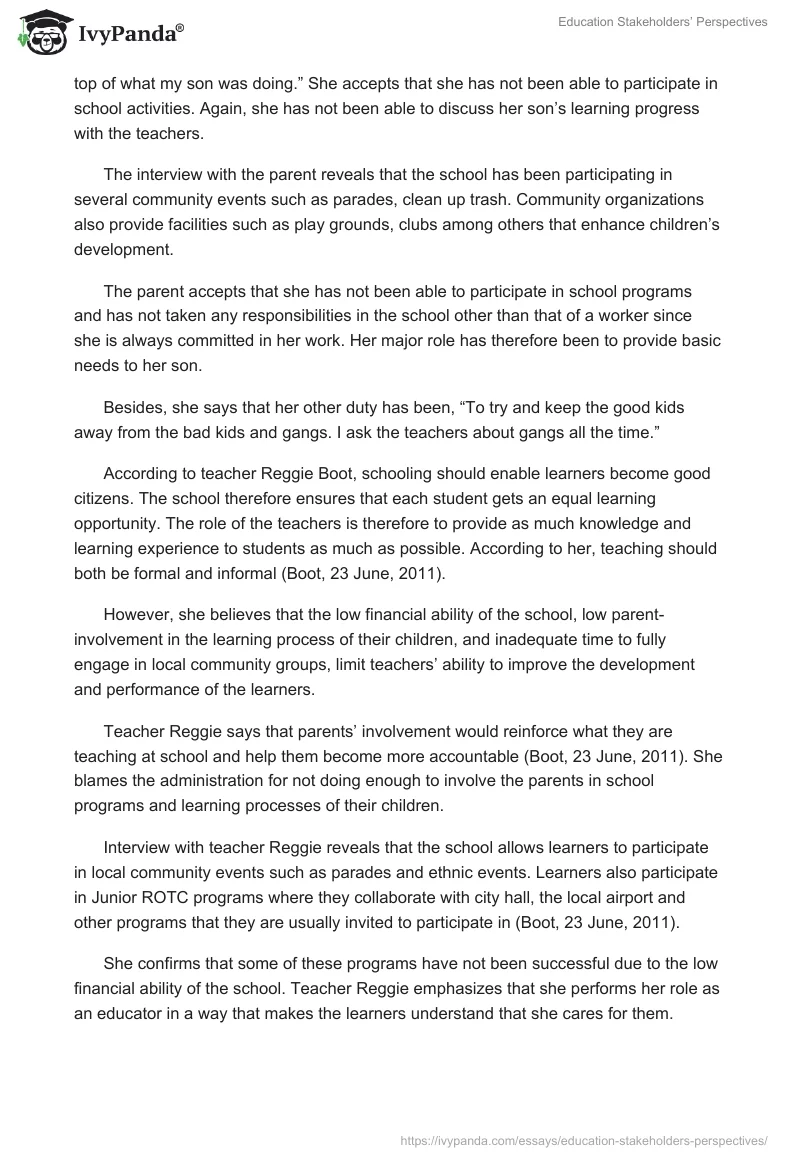Introduction
Many people believe that education is meant to impart knowledge into learners. However, they hold different perceptions regarding the objectives and goals, and importance of schooling. They also have different views as to how these objectives are supposed to be achieved.
For an institution or an education system to achieve its objectives, every stakeholder involved in the education process has to perform his or her role. This document discusses the roles of teachers, parents and school administrators, by analyzing an earlier interview conducted to understand the perspectives of these stakeholders.
The interview will also be discussed to provide an understanding of the importance of schooling and the factors which undermine achievement of schooling objectives.
Results of the interview
The writer interviewed three people; the Vice Principle, Dr. Christopher Gonzales, teacher Reggie Boot, and a parent who works in the same school as a subordinate staff. All of them have some considerable experience and relationship with the school.
Teacher Reggie has been a teacher in this school for the last 4 years, and Dr. Gonzales for the last 17 years. The parent has also been part of the school community for the last 20 years.
According to the parent, the purpose of schooling is to enable children learn so that they are able to get a good job in the future. She believes that the school is doing the much it can to help her son learn because he is provided with enough homework; and besides, the school offers sports programs and Regional Occupation Program.
However, she observed that the school is not doing much to involve the parents in the education processes of their children. The parent says, “It would help me keep on top of what my son was doing.” She accepts that she has not been able to participate in school activities. Again, she has not been able to discuss her son’s learning progress with the teachers.
The interview with the parent reveals that the school has been participating in several community events such as parades, clean up trash. Community organizations also provide facilities such as play grounds, clubs among others that enhance children’s development.
The parent accepts that she has not been able to participate in school programs and has not taken any responsibilities in the school other than that of a worker since she is always committed in her work. Her major role has therefore been to provide basic needs to her son.
Besides, she says that her other duty has been, “To try and keep the good kids away from the bad kids and gangs. I ask the teachers about gangs all the time.”
According to teacher Reggie Boot, schooling should enable learners become good citizens. The school therefore ensures that each student gets an equal learning opportunity. The role of the teachers is therefore to provide as much knowledge and learning experience to students as much as possible. According to her, teaching should both be formal and informal (Boot, 23 June, 2011).
However, she believes that the low financial ability of the school, low parent-involvement in the learning process of their children, and inadequate time to fully engage in local community groups, limit teachers’ ability to improve the development and performance of the learners.
Teacher Reggie says that parents’ involvement would reinforce what they are teaching at school and help them become more accountable (Boot, 23 June, 2011). She blames the administration for not doing enough to involve the parents in school programs and learning processes of their children.
Interview with teacher Reggie reveals that the school allows learners to participate in local community events such as parades and ethnic events. Learners also participate in Junior ROTC programs where they collaborate with city hall, the local airport and other programs that they are usually invited to participate in (Boot, 23 June, 2011).
She confirms that some of these programs have not been successful due to the low financial ability of the school. Teacher Reggie emphasizes that she performs her role as an educator in a way that makes the learners understand that she cares for them.
She recognizes that maintaining positive attitude towards learners and developing positive attitude in learners is the most significant thing to do. This, she says is the way to get low-ability learners involved in the learning process, and help them learn (Boot, 23 June, 2011).
The Vice Principal, Dr. Gonzales confirms that the school provides learners with equal learning opportunities. However, according to him, both learners and teachers have to play their part to achieve the goals of each learner. Dr. Gonzales believes that the purpose of education is to enable learners become what they want (Gonzales, 23 June, 2011), he says, “All children have the same opportunity, it is up to them to apply themselves and it is up to our teachers to pull it out of them.”
He also acknowledges the role of the teachers in modeling learners into good citizens especially those whose parents are very young, and those who have single parents. He believes that the socio-economic status of the learners, inadequate funding, and poor parent involvement in school activities limit the school’s ability to achieve its objectives.
As the school’s vice principal, he attends many civic events to represent the school and voice the school’s interests in such events. He also counsels and mentors teachers and tries to keep them motivated in their work. He monitors teachers to ensure that they are providing quality education to all learners (Gonzales, 23 June, 2011).
He understands that teachers and learners need to be given time to grow in their activities. He is also the liaison between the teachers and the principal. He also confirms the school involves learners in the local community events such as parades, street fairs among others to help learners socialize with the community and community organizations.
On the parents-school relationship, he appreciates that some parents have been able to participate in constructing the snack strands for basketball; volunteer in sporting events, and in home coming (Gonzales, 23 June, 2011).
He says that parents involvement in school activities helps him get know more parents to pass messages of school activities and programs (Gonzales, 23 June, 2011). However, he is disappointed of low parent-involvement in supporting and mobilizing finances for the school.
Implications of the interview
All those interviewed agree that school is very important in molding learners to become successful in their life. The purpose of schooling is therefore to help learners become good citizens, improve their economic status and to be able to equally access opportunities. According to Horace Mann, schooling should develop learners’ capacities, and equally empower them to advance their economic status (Badolato, 2002).
Education enables learners to improve their abilities, skills, knowledge and experience so that they are able to apply them in their daily lives after completion of schooling. It should also be an agent of social change in every learner meaning that it should serve the best interest of the community. This implies that the learners should be provided with an education that integrates them with the society.
To achieve this, learning should not be limited to the school environment, but rather, should be extensive to include learning through interaction with the society and community learning resources. Dr. Gonzales says that they allow learners to participate in community events and also collaborate with many community organizations around the school (Gonzales, 23 June, 2011).
This enhances growth and development of learners to become responsible and active participants of societal systems. Use and interaction with community resources also helps learners develop their other talents and abilities. According to Horace Mann, schooling should develop learners’ capacities, and equally empower them to advance their economic status (Badolato, 2002). Dr. Gonzales also believes that the school need to be more aggressive by involving learners in more school provided activities so as to accomplish its purpose.
All those interviewed confirmed that the administration, teachers and parents unanimously agree that they should all participate in the education process of learners, and school activities and programs.
In school and schooling, teachers play the role of educators. They are also the model of nobility, as well as, self-actualization. In addition, they instill discipline in learners. They have to understand the capacity and nobility in each learner and provide learning opportunities that enable development of these capacities and nobilities in learners (Badolato, 2002).
They have to instill positive attitudes in learners towards learners. According to teacher Reggie Boot, positive attitudes is the most significant thing in the teaching process. This implies that they provide precondition for achieving these objectives, and opportunities for learning experiences that enable them develop all the abilities of learners.
In achieving these objectives, they have to coordinate their activities with the school administration and the parents. The contributions of school administrators and parents are very important in enhancing the role of the teachers.
The school administration ensures that learners get equal learning opportunities regardless of socio-economic and cultural backgrounds. The school administration is also responsible for providing learning resources and organizing opportunities for learning experiences.
The Vice Principal, Dr. Gonzo, says, “I attend many civic event and try and play a significant factor when being a voice for the school.” The school administration is also responsible for monitoring teachers in their duties, and provides motivation to the teachers. Besides, it coordinates parents’ involvement in the school and schooling process. This helps mobilize resources and promote learners’ performance.
Parents play the crucial role of parenting their children. They provide basic needs to their children and ensure that they get learning opportunities by taking them to school. They monitor the performance and progress of their children through teachers’ reports and consultations with the teachers.
They also help mobilize resources and contribute in developing learning facilities for learners. The parent interviewed acknowledges that their role should not be limited to parenting, but should also include participating in school activities and programs.
The major challenge identified in the interview with the Dr. Gonzo, the Vice Principal, teacher Reggie and the parent, is the low financial ability of the school. According to the Vice Principal, financial ability of the school limits its capacity to accomplish its objectives and provide more learning opportunities to learners.
However, despite these challenges, Dr. Gonzales confirms that the school has been able to improve its state test scores (Gonzales, 23 June, 2011).
The perceptions of the different stakeholders interviewed have particular impacts on me as a teacher. First, I understand the purpose of education and how best to achieve the perceived objectives of all those involved in the education process.
I also understand my role as a teacher and how to integrate the parents and the administration in achieving full development of learners. Second, I need to understand the challenges that affect the learning process of learners, and therefore develop strategies to counter the challenges.
Conclusion
From the interviews, we need to understand that teachers, parents, and the school administration play significant roles in the education process of learners. Each individual needs to understand the importance of his or her role in school and schooling.
These roles should be coordinated and each person be enabled to play his or her part effectively. Parents need to understand that their contribution in the school and schooling is very important, and can effectively enhance teachers’ roles, and as a result improve their children’s performance. The administration should therefore coordinate the activities of teachers and parents.
References
Badolato, R. (2002). The educational theory of Horace Mann. NewFoundations. Web.
Koblinsky, S. A, Randolph, S. M & Roberts, D. D. (1996). Studying the role of family, and school in the development of African American preschoolers in the violent neighborhoods. The Journal of Negro Education, 65(5): 282-294.


